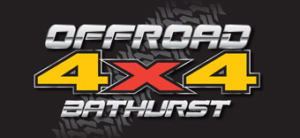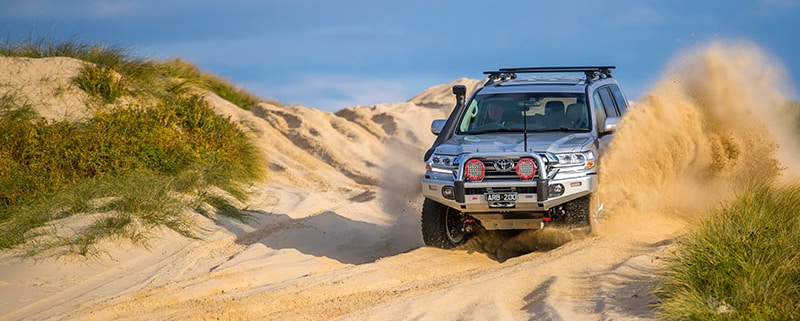4WD Top Tips for Sand and Beach Driving
We love our adventure travel in Australia, and one of the best ways to explore our rugged and beautiful coastlines is by 4WD. 4WDing isn’t for the faint-hearted, and being prepared is the difference between a fun driving experience and a sand-filled nightmare.
Whether you’re driving on the beach for fun, or trying to get to a campsite or crossing, even the most experienced drivers can make mistakes.
Here are some of our top tips for beach driving so you won’t be stranded on your next sand driving adventure.
Do your research
Always check which beaches are 4WD friendly and where vehicles are permitted. Most will have clearly marked access routes and signage, but you can also check with your local tourist centre and camping grounds nearby. Always use an established access route, not just because they are better for your car, but you won’t risk any damage to the local environment and dune ecosystems.
Lighten your load
The lighter the vehicle is of a heavy load, the less likely you are to be bogged. Take out any large or heavy objects in the boot before you go. If you are bogged, unload all your passengers before you attempt to drive out.
Lower your tyre pressure
4WD experts will have slightly different opinions on what to lower you tyres to depending on the terrain you’re on. But as a general rule of thumb, most 4WD vehicles will have a road-driving tyre pressure between 32-38psi, and you’ll need to lower it to 20 psi in most conditions. You lower the tyre pressure to spread out the tyre so you’ll get more traction on the sand.
Don’t go lower than 16psi as you’re starting to run the risk of rolling the tyre bead off the rim below these pressures.
Research the tides
It’s best to aim your trip with an outgoing high tide or a couple of hours before low tide times as this will be when the sand is the hardest and most compact. All beaches are different, and sand quality can change depending on the weather and high tides. If it’s your first time on this beach, always get some local knowledge on the area.
Try and stay clear of the water’s edge – as fun as it looks to drive through the water, just one wave could lift the vehicle.
Keep momentum up
Loose, soft sand is perfect for bogging and if you don’t keep the wheels spinning the car will sink, and you’ll bog pretty quickly. Keep momentum but finding the right balance between a level speed and keeping the wheels spinning is key and it’s also the best way to maximise your fuel usage.
Before you hit the sand turn off the systems traction control to allow power to go to all wheels when you need it.
No sudden movements
The worst away to drive on the sand is with hard, fast, jerky movements. Keep your driving easy and smooth on the brakes, accelerator and steering. When it comes to shopping, don’t do a hard brake but rather coast to a stop.
Park down a slope
When you decide to stop and park, find a small slope in the sand and park facing down the slope. This will create momentum downwards when you go again, and you won’t be fighting gravity by trying to start uphill.
Be prepared to be bogged
Even the most skilled 4WD’ers will get bogged at some point, so being prepared is essential. Shovels, snatch-straps and shackles, a tyre deflator and a compressor, are all essential recovery gear.
If in doubt drive on the hard-packed tracks
Where possible stick to the hard sand or hard-packed tracks by other cars. A typical scenario is when driving you lose forward momentum and your wheels start spinning. Most people’s first reaction is to accelerate, but this will bog the tyres, so it’s better to reverse back over the hard-packed tyres and start again forward for another try.
Be considerate
Follow road rules as you would on normal roads and be considerate to other people on the beach. Avoid tail-gaiting, parking too close to others and give way to other drivers as you would normally do.
Respect the environment
Driving on our beautiful pristine beaches is a privilege, so do the right thing and keep the environment as clean as when you found it. If a plastic bag escapes your car, it’s your responsibility to collect it and collect any other rubbish you might find in your way.
Don’t leave foods scraps that could attract feral dogs and animals who could then pray on native animals. Don’t leave any fishing hooks or lines on the beach and don’t drive on protected sand dunes or vegetation area.
Driving on the beach is a fantastic way to enjoy our beautiful and rugged coastlines, and it’s a privilege that future generations should be able to enjoy as well, so enjoy your 4WDing experience but always be mindful of the environment you’re in.
At Offroad 4×4 Bathurst we have a range of 4×4 accessories to take you to anywhere you want to go.
Contact us today for our 4×4 accessories so you can hit the beach for your next adventure and stay lookout for our next article on 4WD top tips for bush and off-road driving coming soon!










